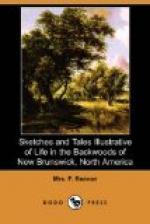known as the “shanty loaf”—his
beverage, or substitute for tea, is made of the leaves
of the winter green, or the hemlock boughs which grow
beside him, and his sweetening being handy bye, he
wants nothing more. A notch is cut in the tree,
from which the sap flows, and beneath it a piece of
shingle is inserted for a spout to conduct it into
troughs, or bark dishes, placed at the foot of the
tree. The cold frosty nights, followed by warm
sunny days, making it run freely, clear as water, and
slightly sweet—from these troughs, or bark
dishes, it is collected in pails, by walking upon
the now soft snow, by the aid of snow shoes, and poured
into barrels which stand near the boilers, ready to
supply them as the syrup boils down. When it
reaches the consistence required for sugar, it is
poured into moulds of different forms. Visits
to these sugar camps are a great amusement of the
young people of the neighbourhood in which they are,
who make parties for that purpose—the great
treat is the candy, made by dashing the boiling syrup
on the snow, where it instantly congeals, transparent
and crisp, into sheets. At first the blazing fire
and boiling cauldron look strange, amid the solemn
loneliness of the forest, along whose stately aisles
of cathedral-like grandeur the eye may gaze for days,
and see no living thing—the ear hear no
sound, save it may be the tapping of the woodpecker,
or the whispering of the wind as it sighs through
the boughs, seeming to mourn with them for the time
when the white man knew them not. But these thoughts
pass away when the proprietor, with his pale intelligent
face, shaded by a flapping sun hat from the glaring
snow, presses us hospitably to “take along a
junk of candy, a lump of sugar,” or a cup of
the syrup. He sees nothing picturesque or romantic
in the whole affair, and only calculates if it will
pay for the time it occupies; at the same time, with
the produce of his labours he is extremely “clever,”
this being the term for generous or hospitable, and
one is sometimes startled at its application, especially
to women; the persons in England, to whom it is applied,
are so unlike the clever women of New Brunswick, those
dear old creatures, who know not the difference between
Milton and Dilworth, and whose very woollen gowns
are redolent of all-spice and apples.
Towards the latter part of March and April the breaking up of the ice goes on gradually—some seasons, however, a sudden storm causes the ice and snow to disappear rapidly, but generally a succession of soft warm winds, and days partly sunshine and rain, does it more effectually, and prevents the heavy freshets in the rivers, which are often destructive, overflowing the low banks and carrying away with resistless force whatever buildings may be on them. After the disappearance of the snow, some time must elapse ere the land be in a fit state for sowing, consequently fencing, and such like, is now the farmer’s employment, either around the new clearings, or in repairing those which




